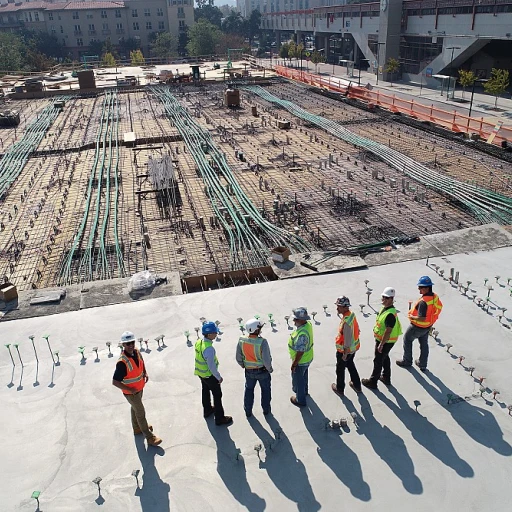The Rise of Augmented Reality in Training
The Evolution of Augmented Reality in Training
Augmented reality (AR) has gradually transformed various industries over the past decade, and the training sector is no exception. With its ability to overlay digital information onto the real world, AR offers a dynamic and immersive experience that traditional training methods simply cannot match. This evolution is driven by a combination of technological advancements and the increasing need for engaging and effective training solutions.
The shift towards augmented reality is primarily fueled by the growing demand for more interactive and personalized training experiences. As the workforce continues to evolve, organizations are seeking innovative ways to upskill their employees, making AR an attractive option due to its ability to provide real-time feedback and hands-on practice. With AR, learners can engage with complex concepts and scenarios in ways that are both intuitive and engaging.
One of the significant advantages of AR in training is its ability to simulate real-world environments and situations. This capability is particularly beneficial for industries that require highly specialized skills or involve high-risk scenarios, where practical training can be challenging to implement. As we explore further in this article, augmented reality allows learners to practice in a safe and controlled setting, making it an invaluable tool for skill development.
AR is not only making waves in professional settings but also in educational institutions where it helps bridge the gap between theoretical knowledge and practical application. By integrating AR into the curriculum, schools and universities can provide students with a hands-on approach to learning, thereby enhancing their understanding and retention of complex subjects.
The rise of augmented reality in training signifies a revolutionary shift in how we perceive and implement learning methodologies. As we delve into the upcoming sections, we will uncover how AR can turn real-time learning into a game-changing experience, exemplified by various industry success stories. For those interested in understanding the broader technological landscape, we also recommend
exploring virtual reality in the workplace as it complements the benefits brought by AR solutions.
Real-Time Learning: A Game Changer
Revolutionizing Learning Experiences
In the ever-evolving landscape of education and professional development, augmented reality (AR) is carving a niche for itself by transforming the way learning is delivered. No longer confined to static manuals or passive video tutorials, AR injects a sense of immediacy and involvement, making learners active participants in their education.
By overlaying digital content onto the real world, AR facilitates real-time learning, an approach that significantly enhances engagement and retention. Imagine a trainee in a factory setting who, rather than reading about machine operations from a manual, uses AR goggles to interact with a 3D model of the machinery. This hands-on experience allows the trainee to learn complex processes and troubleshoot in a simulated yet realistic environment.
The immersion AR offers can lead to quicker mastery of skills, as learners can experiment safely without the looming fear of costly mistakes. This method has gained momentum across various sectors as a game changer, providing tangible benefits that extend beyond traditional training methods.
Moreover, with AR, feedback is instant. Learners can immediately see the results of their actions, adjust their approach, and reinforce their understanding. This dynamic leads to a faster and deeper learning curve, empowering individuals to attain proficiency with remarkable speed.
The move towards real-time learning through AR is not just an upgrade of traditional methods; it's a paradigm shift that is setting a new standard in training and professional development. This transformative potential of AR is only beginning to be tapped, with numerous exciting possibilities on the horizon.
Case Studies: Success Stories from Industry Leaders
Pioneering Success Stories Among Industry Leaders
In the pressing world of today’s industries, swift advancement is key. Several industry front-runners have embraced the transformative potential of augmented reality (AR) to elevate their training processes. This innovative leap not only sets them apart but also reshapes their workforce's skill acquisition in profound ways.
AR applications have been effectively utilized in sectors ranging from healthcare to aviation. For instance, in healthcare, companies like AccuVein have revolutionized the training for nurses by using AR to project a digital image of veins onto a patient’s skin, making procedures like venipuncture both safer and more efficient. This not only enhances learning but also proves to be beneficial in real-world applications where precision is non-negotiable.
Meanwhile, in the field of aviation, companies like Boeing have utilized AR to train employees in the complex assembly processes of aircraft. By overlaying digital instructions onto physical components, trainees gain immediate access to critical guidance, minimizing error rates and strengthening hands-on competence.
Additionally, augmented reality is playing a vital role in fostering collaboration in the automotive industry. BMW, for example, is using AR smart glasses to facilitate real-time remote guidance. This allows technicians in one part of the world to receive instant expert assistance from engineers located thousands of miles away, directly augmenting their training and problem-solving capabilities.
The successes of these industry leaders underline the broader potential of augmented reality for training purposes. As companies across various sectors continue to adopt such technologies, the shift towards more immersive and effective learning environments becomes apparent. This direction not only aligns with emerging future work environments but also sets the stage for ongoing innovation in training practices. For a closer look into how evolving workspaces are adapting to these technological advancements, check out our piece on
future work environments.
Augmented Reality vs. Traditional Training Methods
Comparing New and Old: Transforming Training Practices
Augmented reality's emergence in training has undeniably changed the landscape, but how does it truly compare to traditional methods? Amidst technological advances, the age-old discussion of innovation versus convention gains new momentum. The incorporation of augmented reality into training offers significant advantages over traditional methods, making this technology a pivotal player in workforce development.
One of the key benefits of augmented reality is its ability to provide immersive and interactive learning experiences. Traditional training methods, such as lectures or passive video tutorials, often fail to engage learners fully. In contrast, augmented reality allows learners to actively engage with content, offering hands-on practice in a controlled environment. This interactive experience not only aids in better understanding but also enhances retention by engaging multiple senses.
Furthermore, augmented reality can significantly reduce the costs associated with traditional training. Rather than organizing expensive on-site training sessions, businesses can leverage AR technology for on-the-job training, requiring fewer resources and lowering logistical expenses. This cost-effective advantage makes augmented reality an attractive proposition for companies aiming to optimize their training budgets while achieving substantial learning outcomes.
Another noteworthy advantage is augmented reality's ability to customize training modules in real-time. While traditional training methods often rely on a one-size-fits-all approach, AR training can be tailored to fit individual learning speeds and preferences. This personalized learning experience ensures that employees receive the most relevant and effective training, resulting in improved performance.
It's also essential to consider the safety and scalability benefits of augmented reality compared to traditional methods. In sectors where safety is paramount, AR provides a risk-free environment to practice complex tasks without the potential dangers of real-world application. This is particularly beneficial in high-risk industries where mistakes could lead to severe consequences.
As companies continue to seek new ways to train and develop their workforce, the comparison between augmented reality and traditional training methods highlights the transformative potential of AR. While both have their merits, the dynamic, engaging, and cost-effective nature of augmented reality positions it as a compelling choice for organizations ready to innovate their training practices.
The Role of Augmented Reality in High-Risk Scenarios
Enhancing Safety through Immersive Simulations
When it comes to high-risk scenarios, the presence of augmented reality (AR) in training provides a unique advantage. Traditionally, training for hazardous occupations—such as firefighting, aviation, or medical surgery—has leaned heavily on controlled environments or physical simulations, which can be costly and sometimes insufficiently realistic. With AR, however, trainees can immerse themselves in simulations that mimic real-world dangers without any actual risk, thereby preparing them comprehensively for genuine emergencies.
AR technology can simulate conditions such as smoke-filled rooms for firefighters or emergency landings for pilots, all while offering real-time feedback and allowing for repeated practice until proficiency is achieved. This no-risk learning environment not only enhances safety but also boosts confidence and readiness among trainees. Unlike traditional methods, which might use mannequins or basic controls, AR environments are dynamic and interactive, creating more engaging, lifelike experiences.
Additionally, AR-based training allows for the real-time tracking of a trainee’s performance, providing immediate insights into skills that need improvement. Such detailed analytics, which are typically not available in conventional training, aid trainers in tailoring sessions to individual needs, ensuring a more personalized and effective learning path.
It's evident that as AR technology becomes more sophisticated, its role in high-risk training scenarios will continue to expand, bridging the gap between theoretical knowledge and practical application, ultimately elevating the standards of preparedness and safety in these critical fields.
Future Prospects: The Next Steps in Augmented Reality Training
The Untapped Potential of Augmented Reality in Training
As we've journeyed through the exciting world of augmented reality (AR) in training, it's clear that this technology holds transformative potential. While industry leaders have already set benchmarks with their pioneering efforts, the horizon is brimming with possibilities. The continuous evolution in AR technology promises to further refine training experiences, making them more interactive and personalized.
One area where we can expect significant advancements is the integration of AI within AR platforms. Artificial Intelligence can add layers of intelligence to AR applications, leading to more intuitive interactions and immersive learning environments. By analyzing user behavior and preferences, AI can tailor training modules to fit individual learning styles, thus maximizing engagement and efficiency.
Furthermore, the development of more sophisticated wearable technology will play a pivotal role. Lighter, more ergonomic AR glasses and headsets will make prolonged usage more comfortable, thus widening accessibility in diverse training contexts. This could result in more widespread adoption of AR training across various sectors, from healthcare to aviation, enhancing real-time learning and skill acquisition.
While many organizations are already on board with AR, the rapid advancements suggest that those sitting on the sidelines may soon find themselves at a competitive disadvantage. The potential upgrades in bandwidth and network capabilities, such as the widespread adoption of 5G, will further supplement the functionality and seamless delivery of AR content.
The future holds exciting prospects as industries move towards a more digital and immersive training landscape. Companies that are early adopters of AR training will be better positioned to harness the full potential of their workforce, fostering a culture of continuous learning and innovation. As we look ahead, it's not merely about keeping pace with technological change but embracing the vast opportunities it brings.














